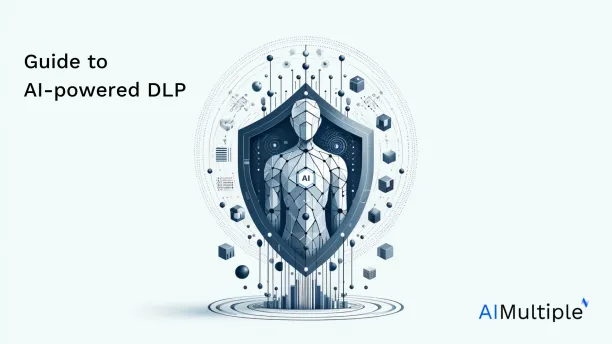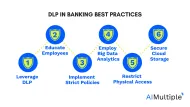We analyzed the leading DLP software and, based on our experience with DLP solutions, we identified best practices supported by case studies. See how AI can enhance your data security:
Leveraging automated DLP software
Case study: Aspire Pharmaceuticals
Aspire Pharmaceuticals needed to safeguard a vast array of sensitive data, requiring detailed policy control and real-time responsiveness to access level adjustments. The company implemented an automated DLP solution that offered the following benefits, making the data protection process more efficient:
- Detailed control over user access rights
- Quicker response to policy changes
- Comprehensive documentation
The case study covers:
1. AI-enhanced detection and response
The cornerstone of a robust DLP strategy is the implementation of AI-powered DLP software tools. These advanced systems are designed to automatically detect sensitive data across a network, employing machine learning algorithms and natural language processing to identify and classify data elements with precision.
Unlike legacy DLP solutions, AI-driven software can adapt and learn from more historical data, reducing false positives and ensuring that high-risk data resources receive the attention they deserve.
2. Real-time monitoring and granular controls
AI DLP tools provide real-time monitoring and immediate alerts on potential threats, enabling quick responses to prevent data leaks. With granular controls for fine-tuning security policies to align with organizational needs, they secure sensitive data against unauthorized access and support regulatory compliance, making them indispensable for modern businesses.
The efficiency cannot be matched manually; an automated tool excels in real-time monitoring and granular controls, processing data faster and adjusting security measures more precisely, thus ensuring optimal protection and compliance.
Here is a guide to the top automated DLP software on the market.
Using predictive analytics to prevent data breaches
Case study: John Hopkins
Challenge
Johns Hopkins faced growing concerns over patient privacy breaches and needed to enhance its healthcare data security measures.
Solution
The institution implemented an AI-powered application to develop a highly accurate privacy analytics model. This model meticulously reviewed every access point to patient data, identifying potential privacy violations, attacks, or breaches.
Utilizing both supervised and unsupervised machine learning techniques, along with transparent AI methods, Johns Hopkins advanced its data security framework. This led to the establishment of a predictive, analytics-based, and collaborative privacy analytics infrastructure that effectively protects patient information.
The case study covers:
3. Harnessing the power of AI models
Predictive analytics, powered by AI models, is transforming data security by forecasting potential data breaches before they materialize. By analyzing patterns and hidden trends within data flows, AI tools can identify unusual behavior that may signify a security risk. This preemptive capability enables security teams to identify and address vulnerabilities, thereby strengthening their defenses and effectively reducing the risk of a data breach.
4. Enhancing data security with machine learning
Machine learning algorithms play a pivotal role in enhancing predictive analytics for data loss prevention. By continuously learning from past incidents and security breaches, these algorithms become increasingly adept at detecting subtle signs of impending threats. This ongoing improvement in threat detection makes AI-powered predictive analytics an invaluable component of a forward-thinking cybersecurity strategy.
AI-driven employee monitoring and access control
Case studies:
- EuroFinance Bank implemented AI-driven security solutions to monitor employee activities and detect anomalies, significantly reducing cyber threats and insider risks. Their AI security platform improved incident response and reduced attempted data breaches by over 85%. 1
- Heritage Banking Group introduced an AI-powered data access management system that dynamically controls and monitors access to sensitive information, thereby reducing unauthorized access and insider threats. This resulted in a 60% decrease in fraud cases.
The case studies cover:
5. Monitoring for policy violations
One of the more direct approaches to data loss prevention involves monitoring employee access and activities to detect and prevent policy violations. AI DLP solutions excel in this area by providing complete visibility into how sensitive information is handled within the organization. This includes tracking data access, sharing, and storage, ensuring that all actions comply with company policies and data protection standards.
6. Intelligent access control
To further secure sensitive data, AI-driven systems can implement intelligent access control measures. By analyzing employee roles, behaviors, and data handling patterns, AI tools can automatically adjust access privileges, ensuring that individuals have access only to the data necessary for their roles.
For more on access control:
Leveraging AI in device control
7. Device control for hybrid work models
AI-driven systems enhance data security by implementing intelligent access controls.
This minimizes the risk of internal data leaks and ensures sensitive information like personally identifiable information (PII) and financial data is accessed responsibly and securely.
8. Use automated USB encryption
To safeguard devices in a hybrid work model, companies can implement AI-driven security measures that include automatic USB encryption. This ensures that any sensitive data transferred to USB drives is automatically encrypted, reducing the risk of data breaches.
AI can monitor device behavior and automatically apply encryption protocols to USB devices, enhancing data security without disrupting user productivity.
You can also use software with USB-blocking capabilities.
Automated anomaly detection
9. Identifying anomalous behavior
Anomaly detection is a critical aspect of AI-powered DLP, enabling organizations to identify unusual patterns and behaviors that could indicate a security threat.
By leveraging large language models and machine learning algorithms, AI tools can sift through vast amounts of data in real-time, pinpointing activities that deviate from the norm. This allows security teams to swiftly investigate and mitigate potential threats before they escalate into full-blown data breaches.
10. Continuous learning and adaptation
The strength of AI in anomaly detection lies in its ability to learn and adapt over time. As AI models are exposed to more data and incidents, their ability to discern between benign anomalies and genuine threats improves, reducing the incidence of false positives.
This continuous refinement of detection capabilities ensures that organizations can stay one step ahead of cybercriminals, safeguarding their data with unparalleled precision.
11. Study on the healthcare sector
A study examined the application of AI in enhancing healthcare security, focusing on anomaly detection, predictive analytics, access control, threat intelligence, and incident response.
The results showed that AI significantly enhances anomaly detection in healthcare systems by efficiently processing vast amounts of real-time data.2
Key findings:
- AI systems monitored access logs to detect unusual behavior and potential security threats.
- Predictive analytics helped anticipate breaches before they occurred, enabling the implementation of proactive security measures.
- AI-enhanced access control and threat intelligence improved data security by identifying unauthorized access attempts.
AI-powered education and training programs
Case studies:
- Higher education institutions: Enterprise AI accounts & training
- Universities like those mentioned in EdTech Magazine enforce the use of enterprise AI accounts (e.g., Microsoft Copilot) under institutional licenses. This ensures data used in AI tools isn’t exploited for model training. Regular AI security workshops and “brown bag” discussions are held to demonstrate ethical AI use, with innovators showcasing compliant applications. 3
- Microsoft’s AI readiness simulation
- Microsoft Purview provides educational institutions with AI activity dashboards and pre-built policies for data loss prevention (DLP). For example, its Copilot monitoring tools simulate phishing attempts and data leakage scenarios, offering employees instant feedback on secure responses. Training modules are accessible anytime, fostering continuous engagement. 4
The case studies cover:
12. Leveraging chatbots and generative AI
Educating employees about data security and best practices is a vital component of a comprehensive data loss prevention (DLP) strategy. AI-powered education and training programs, including AI chatbots and generative AI tools, can provide interactive and personalized learning experiences for employees.
These AI applications can simulate potential security scenarios, guide users through the best responses, and offer instant feedback, reinforcing the importance of data protection in everyday activities.
13. Continuous learning and engagement
The advantage of using AI tools for education lies in their ability to offer continuous learning opportunities. Unlike traditional training sessions, AI-driven programs can be accessed at any time, allowing employees to stay up-to-date on the latest security policies and practices.
This constant engagement not only fosters a culture of data security awareness but also empowers employees to become active participants in the organization’s data loss prevention efforts.
Recommendation
However, since policies and regulations are constantly changing, you need to ensure that your chatbot is regularly trained on the latest data.
Watch this to see how chatbots can educate, train, and assist employees:
Integrating automated DLP with cloud security and SSE platforms
Case studies:
- Polymer DLP for generative AI platforms
- Polymer’s NLP-based DLP solution secures generative AI tools like ChatGPT by redacting sensitive data in real time. It integrates with cloud apps (Slack, Teams) via APIs, automatically enforcing policies without disrupting user productivity. This approach eliminated 70% of manual policy adjustments for a financial services client. 5
- Q2’s PCI DSS compliance via tokenization
- Q2 leveraged ALTR’s cloud DLP platform to tokenize credit card data processed by its Biller Direct app. AI-driven real-time monitoring and policy enforcement ensured PCI DSS compliance, even as data moved between on-premises and cloud systems. Automated alerts reduced breach investigation times by 50%. 6
The case studies cover:
14. Cloud-based data loss prevention
As businesses increasingly migrate to cloud environments, integrating automated data loss prevention (DLP) with cloud security becomes paramount. AI-driven data loss prevention solutions are uniquely equipped to monitor and protect sensitive data across cloud platforms and SaaS apps.
These systems provide visibility into data stored in the cloud, detect sensitive data in transit, and enforce security policies to prevent unauthorized access or data leaks.
15. Synergy with SSE platforms
The synergy between AI DLP and Security Service Edge (SSE) platforms enhances data protection in cloud environments. By incorporating AI DLP solutions into SSE frameworks, organizations can leverage advanced security features, including real-time monitoring, anomaly detection, and predictive analytics.
This integrated approach ensures that sensitive data remains secure, regardless of where it resides, and supports businesses in maintaining regulatory compliance and safeguarding their intellectual property in the cloud.

FAQ
How does AI improve traditional Data Loss Prevention (DLP) strategies?
AI enhances DLP by automating data detection, classification, and response workflows. Machine learning algorithms analyze historical and real-time data patterns to identify sensitive information (e.g., PII, financial records) with greater precision than rule-based systems. Natural Language Processing (NLP) enables contextual understanding of unstructured data, while predictive analytics anticipates risks like breaches before they occur. Unlike static legacy tools, AI systems adapt dynamically to new threats, refining policies and reducing false positives over time.
What role does AI play in securing hybrid work environments?
AI enhances hybrid work security by providing intelligent device control, which adjusts access privileges based on user roles, behavior, and data-handling patterns. It automates USB encryption to secure sensitive data on removable drives and monitors device activity in real time to flag anomalies like unauthorized access attempts. These capabilities minimize internal data leaks while maintaining productivity and compliance.
Can AI help train employees on data security practices?
Yes. AI-powered training tools use chatbots and generative AI to simulate security scenarios (e.g., phishing attacks) and guide users through secure responses. Training content adapts to individual roles and knowledge gaps, providing personalized learning experiences. AI systems also update materials automatically as policies or regulations evolve, ensuring continuous education without manual intervention.
Why is integrating AI DLP with cloud security platforms important?
Cloud environments require real-time protection for distributed data. AI DLP integrates with cloud and Security Service Edge (SSE) platforms to monitor sensitive data across SaaS applications and cloud storage, enforce policies such as automatic access blocking, and ensure compliance with standards like GDPR or PCI DSS. This unified approach safeguards data in transit, at rest, or in use, even in complex multi-cloud setups.
Further reading
- LLM Data Guide & 6 Methods of Collection
- How AI Transforms Cybersecurity
- Agentic AI for Cybersecurity
External resources
- 1. AI in Banking [20 Case Studies] [2025] - DigitalDefynd.
- 2. AI for Enhanced Healthcare Security: An Investigation of Anomaly Detection, Predictive Analytics, Access Control, Threat Intelligence, and Incident Response | Journal of Advanced Analytics in Healthcare Management .
- 3. How Higher Ed Institutions Are Using Built-In Generative AI Tools | EdTech Magazine.
- 4. AI Governance in Higher Education: Case Studies of Guidance at Big Ten Universities.
- 5. The top use cases for DLP - Polymer. Polymer
- 6. 10+ Data Governance Case Studies: Real-Life Examples. AIMultiple



Comments
Your email address will not be published. All fields are required.